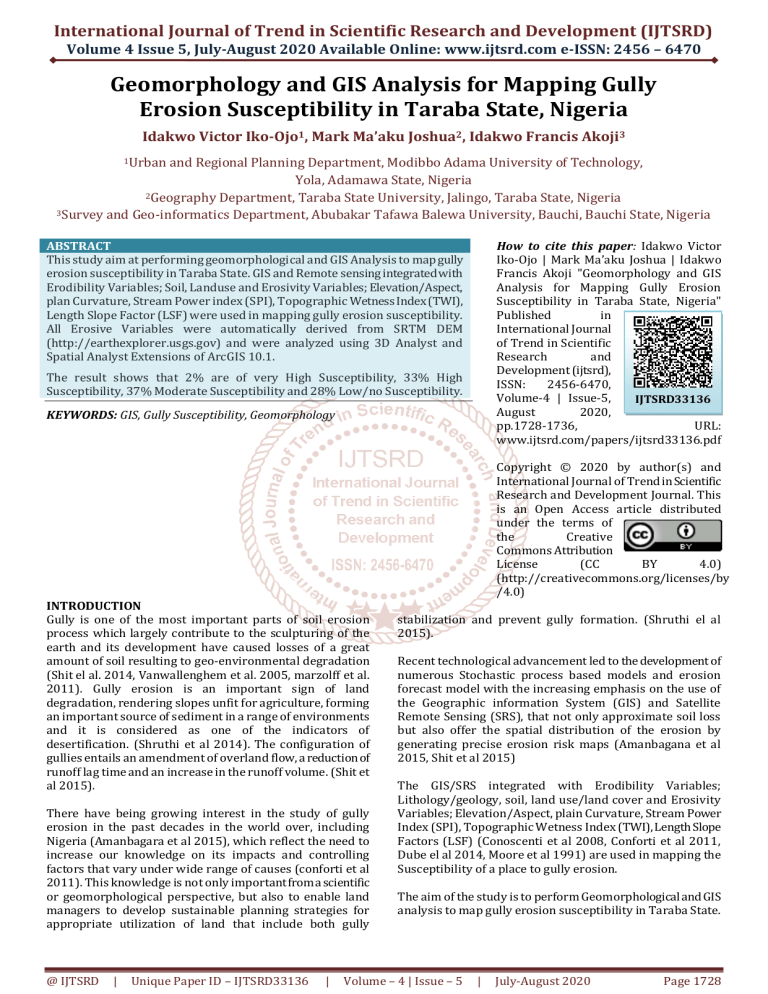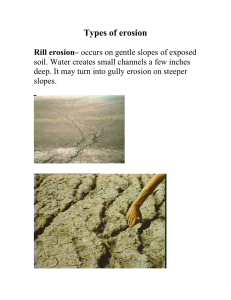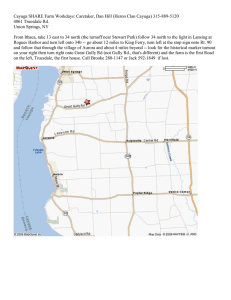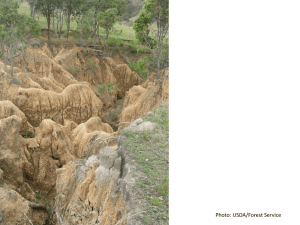
International Journal of Trend in Scientific Research and Development (IJTSRD)
Volume 4 Issue 5, July-August 2020 Available Online: www.ijtsrd.com e-ISSN: 2456 – 6470
Geomorphology and GIS Analysis for Mapping Gully
Erosion Susceptibility in Taraba State, Nigeria
Idakwo Victor Iko-Ojo1, Mark Ma’aku Joshua2, Idakwo Francis Akoji3
1Urban
and Regional Planning Department, Modibbo Adama University of Technology,
Yola, Adamawa State, Nigeria
2Geography Department, Taraba State University, Jalingo, Taraba State, Nigeria
3Survey and Geo-informatics Department, Abubakar Tafawa Balewa University, Bauchi, Bauchi State, Nigeria
ABSTRACT
This study aim at performing geomorphological and GIS Analysis to map gully
erosion susceptibility in Taraba State. GIS and Remote sensing integrated with
Erodibility Variables; Soil, Landuse and Erosivity Variables; Elevation/Aspect,
plan Curvature, Stream Power index (SPI), Topographic Wetness Index (TWI),
Length Slope Factor (LSF) were used in mapping gully erosion susceptibility.
All Erosive Variables were automatically derived from SRTM DEM
(http://earthexplorer.usgs.gov) and were analyzed using 3D Analyst and
Spatial Analyst Extensions of ArcGIS 10.1.
How to cite this paper: Idakwo Victor
Iko-Ojo | Mark Ma’aku Joshua | Idakwo
Francis Akoji "Geomorphology and GIS
Analysis for Mapping Gully Erosion
Susceptibility in Taraba State, Nigeria"
Published
in
International Journal
of Trend in Scientific
Research
and
Development (ijtsrd),
ISSN:
2456-6470,
Volume-4 | Issue-5,
IJTSRD33136
August
2020,
pp.1728-1736,
URL:
www.ijtsrd.com/papers/ijtsrd33136.pdf
The result shows that 2% are of very High Susceptibility, 33% High
Susceptibility, 37% Moderate Susceptibility and 28% Low/no Susceptibility.
KEYWORDS: GIS, Gully Susceptibility, Geomorphology
INTRODUCTION
Gully is one of the most important parts of soil erosion
process which largely contribute to the sculpturing of the
earth and its development have caused losses of a great
amount of soil resulting to geo-environmental degradation
(Shit el al. 2014, Vanwallenghem et al. 2005, marzolff et al.
2011). Gully erosion is an important sign of land
degradation, rendering slopes unfit for agriculture, forming
an important source of sediment in a range of environments
and it is considered as one of the indicators of
desertification. (Shruthi et al 2014). The configuration of
gullies entails an amendment of overland flow, a reduction of
runoff lag time and an increase in the runoff volume. (Shit et
al 2015).
There have being growing interest in the study of gully
erosion in the past decades in the world over, including
Nigeria (Amanbagara et al 2015), which reflect the need to
increase our knowledge on its impacts and controlling
factors that vary under wide range of causes (conforti et al
2011). This knowledge is not only important from a scientific
or geomorphological perspective, but also to enable land
managers to develop sustainable planning strategies for
appropriate utilization of land that include both gully
@ IJTSRD
|
Unique Paper ID – IJTSRD33136
|
Copyright © 2020 by author(s) and
International Journal of Trend in Scientific
Research and Development Journal. This
is an Open Access article distributed
under the terms of
the
Creative
Commons Attribution
License
(CC
BY
4.0)
(http://creativecommons.org/licenses/by
/4.0)
stabilization and prevent gully formation. (Shruthi el al
2015).
Recent technological advancement led to the development of
numerous Stochastic process based models and erosion
forecast model with the increasing emphasis on the use of
the Geographic information System (GIS) and Satellite
Remote Sensing (SRS), that not only approximate soil loss
but also offer the spatial distribution of the erosion by
generating precise erosion risk maps (Amanbagana et al
2015, Shit et al 2015)
The GIS/SRS integrated with Erodibility Variables;
Lithology/geology, soil, land use/land cover and Erosivity
Variables; Elevation/Aspect, plain Curvature, Stream Power
Index (SPI), Topographic Wetness Index (TWI), Length Slope
Factors (LSF) (Conoscenti et al 2008, Conforti et al 2011,
Dube el al 2014, Moore et al 1991) are used in mapping the
Susceptibility of a place to gully erosion.
The aim of the study is to perform Geomorphological and GIS
analysis to map gully erosion susceptibility in Taraba State.
Volume – 4 | Issue – 5
|
July-August 2020
Page 1728
International Journal of Trend in Scientific Research and Development (IJTSRD) @ www.ijtsrd.com eISSN: 2456-6470
THE STUDY AREA
The research was carried out in Taraba State, Nigeria. It is located at the North Eastern part of the country at 8˚00’N, 10˚30’E,
covering a total area of 54,473 km2
MATERIAL AND METHODS
In this research two variables were considered, under which some factors were analyzed. Erodibility variables – Soil and Land
use, Erosivity variables – Elevation/Aspect, Plan Curvature, Stream Power index(SPI), Topographic Wetness index (TWI),
Length Slope Factor (LSF). All the erosivity variables were automatically derived from Digital elevation Model DEM, provided
by the Shuttle Radar Topography Mission (SRTM). The SRTM DEM was downloaded from USGS Earth Explorer:
http://earthexplorer.usgs.gov. These were Analyzed using 3D Analyst and Spatial Analyst extensions of ArcGIS 10.1.
VARIABLE ANALYSIS
Land Cover:
Barren/Bare and sparsely Vegetated areas are affected by faster erosion and greater instability than forest (conforti et al 2011)
and dense vegetative cover; because the later decrease effects of gully erosion susceptibility as surface runoff are reduced. In
this study land use map was derived from image classification of Landsat 8 image (downloaded from USGS Earth explorer). The
land use types were grouped into four classes, built-up area, vegetation, bare land and water body.
SOIL MAP
The soil map of Taraba was extracted from the Digital soil Map of the world (worldmap.havard.edu/data/geonage: DSMW_Rdy)
which was grouped into four classes.
@ IJTSRD
|
Unique Paper ID – IJTSRD33136
|
Volume – 4 | Issue – 5
|
July-August 2020
Page 1729
International Journal of Trend in Scientific Research and Development (IJTSRD) @ www.ijtsrd.com eISSN: 2456-6470
SLOPE
The steepness is one of the important factors that induce land evolution because it affects run off, drainage density and soil
erosion. The steeper the slope the higher runoff velocity, consequent rill and gull initiation. (Conforti et al 2011, Valentin et al
2005). In this study the slope was generated from the SRTM DEM using surface tool, in the spatial analyst toolbox of the Arctool
in ArcGIS and was reclassified into four classes using Classify tool, in the Spatial analyst toolbox of the Arctool in ArcGIS.
ASPECT
Aspect is also considered as an important factor in susceptibility studied of denudational process. It is expressed in degree from
noerth clockwise, ranging from 0 to 360. (conforti et al 2011, Carrar et al 1991, Maharaj 1993, Guzzelli et al 2000).
PLANE CURVATURE
This is the rate of change of slope gradient or aspect, usually in a particular direction. The influence of plane curvature on slope
erosion processes in the convergence or divergence of water during down slope flow. Positive (>0) value of plane curvature
define convexity while Negative (<0) value define concavity (Willson & Gallant 2000, conforti et al 2011)
LENGTH SLOPE FACTOR
This is the relationship between surface runoff speed and sediment transportation which is determine using flow accumulation
and slope using the equation described by moore and Bunch 1986):
LS = (Fa × cellsize/22.13)0.4 × sinб/0.0896)1.3
Fa = Flow Accumulation
б = Slope in degree
The flow accumulation was generated using hydrology tool while the final equation was model using Raster calculator of
algebra tool, all in the Spatial Analyst tool box for Arctool box of ArcGIS 10.1.
TOPOGRAPHIC WETNESS INDEX (TWI)
This is the effect of topography on the location and size of saturated source areas of runoff generation (Confeti et al 2011).
Moore el al (1991) described the equation below for TWI:
TWI = In(AS/tanб)
AS = specific catchment area in meter (in the study case km)
б = Slope gradient in degree
RANKING/WEIGHTED OVERLAY
Ranking is the decision based on order of importance of criteria to be considered. In the first step, criterion are ranked in order
of their importance, in the second step ranking method is used to obtain numerical weights from this order (Blistanova et al
2016, meyer 2007). Rank Sum Method (yahaya et al 2010) was used to calculate normalized weights of the criteria.
Wj = n – rj + 1/sum (n – rk + 1)
Wj is the normalized weight of each factor
n is the number of factors under consideration (k = 1,3…n)
rj is the rank position of the factor
Weighed overlay is the overlay of criterion based on assigned weight to map the final susceptibility. The following equation was
adopted
GS = sum (F1 *WJ1 + F2*WJ2 …………… F7*WJ7)
GS = Gully Susceptibility
F1, F2….. F7 = respective factors
WJ1, WJ2 ……. WJ7 = the normalized weights
@ IJTSRD
|
Unique Paper ID – IJTSRD33136
|
Volume – 4 | Issue – 5
|
July-August 2020
Page 1730
International Journal of Trend in Scientific Research and Development (IJTSRD) @ www.ijtsrd.com eISSN: 2456-6470
RESULT AND DISCUSSION
FACTORS
Land use
SOIL
Topographical Wetness Index (TWI)
Plane Curvature
Length Slope Factor (LSF)
Slope
Aspect
LAND COVER
@ IJTSRD
|
FACTOR,S CLASSES
Water body
Builtup Area
Vegetative Area
Bare land
Acrisols/Leptosols/Arenosols/Lithosols
Nitisols
Luvisols
Vertisols/fluvisols
0.804 –9.857
9.857 –11. 339
11.339 –12.738
12.738 –21.790
Flat
Convex
Concave
0 – 1,543.3
1,543.3 –6,834.6
6,834.6 –19,180.8
19,180.8 –56,219.9
0 – 1.875
1.875 –5.0887
5.0887 –9.6417
9.6417 –22.7650
Flat
Convex
concave
RANKS
1
2
3
4
1
2
3
4
1
2
3
4
2
3
4
1
2
3
4
1
2
3
4
2
3
4
LENGTH SLOPE FACTOR
Unique Paper ID – IJTSRD33136
|
Volume – 4 | Issue – 5
|
July-August 2020
Page 1731
International Journal of Trend in Scientific Research and Development (IJTSRD) @ www.ijtsrd.com eISSN: 2456-6470
ASPECT
PLANE CURVATURE
TOPOGRAPHIC WETNESS INDEX
@ IJTSRD
|
Unique Paper ID – IJTSRD33136
SLOPE
|
Volume – 4 | Issue – 5
|
July-August 2020
Page 1732
International Journal of Trend in Scientific Research and Development (IJTSRD) @ www.ijtsrd.com eISSN: 2456-6470
SOIL
@ IJTSRD
|
FACTOR
RANK
ASSIGNED WEIGHT
WEIGHT %
Topographic wetness index
1
0.25
25
Length slope factor
2
0.2142
21
Land use
3
0.1785
18
soil
4
0.142
14
Plane curvature
5
0.1071
11
aspect
6
0.0714
7
Slope
7
0.03571
4
0.99891
100
Unique Paper ID – IJTSRD33136
|
Volume – 4 | Issue – 5
|
July-August 2020
Page 1733
International Journal of Trend in Scientific Research and Development (IJTSRD) @ www.ijtsrd.com eISSN: 2456-6470
@ IJTSRD
|
SUSCEPTIBILITY
AREA (HECTARE)
LOW
169
MODERATE
224572
HIGH
2011945
VERY HIGH
507
Unique Paper ID – IJTSRD33136
|
Volume – 4 | Issue – 5
|
July-August 2020
Page 1734
International Journal of Trend in Scientific Research and Development (IJTSRD) @ www.ijtsrd.com eISSN: 2456-6470
VALIDATED GULLY
20
CORRECT
17
FALSE
3
ACCURACY OF VISUAL INTERPRETATION
85%
In the field validation work, 20 gullies were observed and later study showed that 18 gullies were captured correctly, while 3
points were false. Nevertheless, the overall accuracy of gully interpretation reached 85%
Conclusions
In this study, the geomorphological and GIS analyses were
used to characterize the morphological features and spatial
distribution of gully areas and the most influential factors of
gully erosion development. Gully susceptible areas were
delineated Considering Erodibility and Erosivity features of
Taraba State, the analysis shows the relationship between
Erodibility Variables; Soil, Landuse and Erosivity Variables;
Elevation/Aspect, plan Curvature, Stream Power index (SPI),
@ IJTSRD
|
Unique Paper ID – IJTSRD33136
|
Topographic Wetness Index (TWI), Length Slope Factor
(LSF) and how they influence gully development. From the
result it shows the 507 hectares of Taraba state have very
High Susceptibility to Gully development, 2011945 hectares
are highly susceptible, 224572 Hectares are moderately
susceptible while 169 hectares have low susceptibility to
gully development.
Volume – 4 | Issue – 5
|
July-August 2020
Page 1735
International Journal of Trend in Scientific Research and Development (IJTSRD) @ www.ijtsrd.com eISSN: 2456-6470
As such, the proposed model helps to decision makers to
delineate the high and low susceptible areas in relation to
gully erosion and to develop suitable soil and water
conservation practices. The Validation data shows
satisfactory accuracy of 85% between the gully erosion
prone map and gully location data obtained from the field.
This methodology can also be used in the other areas to
delineate the gully susceptible zone.
Bibliography
[1] Amambagara G T, Njoku J D, Obenade M. (2015).
Applying Satellite Remote Sensing and GIS in the Study
of Gully Erosion. Journal of Scientific Reseach and
Reports, 4(3), 253 - 264.
[2] Blistanova m, Zelenakova M, Blistan P, Vojtech Ferencz.
(2016). Assessment of Flood Vulnerability in Bodva
River Basin, Slovakia. Acta montanistica Slovaca, 21(1),
19-28.
[3] Carrar A, Cardinali M, Delti R, Guzzetti F, Pasqui V,
Reichenbash P. (1991). GIS Techniques and Statistical
Models in Evaluating Landslide hazard. Earth Surf Proc,
land 16, 427-445.
[4] Chen Y., Khan S., Paydar Z. (2010). To Retire of Expand.
A fuzzy GIS Based Spatial Multi-Criteria Evaluation
Framework for irrigated Agriculture. Irrigation and
Drianage , 17-188.
[5] Conoscenti C, Di maggio C, Motighano E. (2008). Soil
erosion Susceptibility Assessment and validation using
a Geostatistical Multivariate Approach: A Test in
Southern Sicily. Nat Hazard, 46, 287-305.
[6] Dube F, Nhapi I , Murwira A, Gumindoga w, Goldin J,
Mashauri D A. (2014). Potential of Weight of Evidence
modelling for Gully Erosion Hazard Assessment in
Mbire District-Zimbabwe. Phys Chem Earth, 67-69, 145152.
[7] Getachew T. Ayehu and Solomon A.Besufekad. (2015).
Land Suitability Analysis for Rice production: A GIS
based Multi-criteria Decision Approach. Americal
Journal of Geographic Information System, 4(3), 95-104.
[8] Guzzetti F, Carrara A, Cardinali M, Reichenbach P.
(1990). Landslide Hazard Evalustion: A Review of
Current Techniques and Their Application in a Multiscale Study, Central Italy. Geomorphology, 31, 181-216.
[9] Maharaj, R. (1993). Landslide Process and Landslide
Susceptiblity Analysis from. 34, 53-79.
[10] Marzolff I, Ries J B, Poesen J. (2011). Short-term Verses
Meium-term Monitoring for Detecting Gully-Erosion
Variables in a mediteranean Environment. Earth Surf
Process. Land Forms, 36, 1604-1623.
[13] Shit P K, Bhunia G S, Maiti R. (2014). Morphology and
Development of selected Badlands in South Bengal
(India),. indian J Geogr Environ, 13, 161-171.
[14] Shit P K, Paira R, Bhunia G, Maiti R. (2015). Modeling of
Potential Gully Erosion hazard using Geospatial
Technology at Garbheta Block, West Bengla in India.
Model.Earth syst.Environ, 1, 2.
[15] Shruthi Bajesh B V, Kerle N, Jethen , Abdellah L,
Machmach I. (2014). Quantifying temporal Changes in
Gully Erosion Areas with Object Oriented Analysis.
Elsevier B.v, catena 128, 262-277.
[16] Vanwalleghem T, Poesen J, Nachtergaele J, Verstraeten
G. (2005). Characteristics, controlling Factors and
importance of Deep Gullies under Cropland on loss
derived Soils. Geomorphology, 69, 76-92.
[17] Wilson J P, Gallant J C. (2000). Terrain Analysis
Principles and Applications. Toronto Canada: Wiley.
[18] Yahaya S, Ahmad N and Ahdalla F R. (2010).
Multicriteria Analysis for Flood Vulnerable Areas in
Hadejia-Jamaare River Basin, Nigeria. European Journal
of Scientific Research, 42(1), 71-83.
[19] Poesen, J. (2011). Challenges in Gully Erosion Research.
Landform Analysis, 16, 5-9.
[20] Valentin, C., Poesen, J., & Li, Y. (2005). Gully Erosion: A
Global Issue. Proc. Seond Int. Sympossium on Gully
Erosion, Chengdu, China, May 2002. Catena, 6 (2-3),
129-330.
[21] Gomez-Gutierrez, A.; Conoscenti, C.; Angileri, S.E.;
Rotigliano, E.; Schnabel, S. Using topographical
attributes to evaluate gully erosion proneness
(susceptibility) in two Mediterranean basins:
Advantages and limitations. Nat. Hazards 2015, 79,
S291–S314.
[22] Vandekerckhove, L.; Poesen, J.; Govers, G. Medium-term
gully headcut retreat rates in Southeast Spain
determined from aerial photographs and ground
measurements. Catena 2003, 50, 329–352.
[23] Ries, J. B.; Marzolff, I. Monitoring of gully erosion in the
Central Ebro Basin by large-scale aerial photography
taken from a remotely controlled blimp. Catena 2003,
50, 309–328.
[24] Johansen, K., Tiede, D., Blaschke, T., Arroyo, L.A., and
Phinn, S., 2011. Automatic geographic object based
mapping of streambed and riparian zone extent from
LiDAR data in a temperate rural urban environment,
Australia. Remote Sensing, 3, pp. 1139-1156.
[25] Guzzetti F, Carrara A, Cardinali M, Reichenbach P
(1999) Landslide hazard evaluation: a review of
current techniques and their application in a multiscale study, Central Italy. Geomorphology 31:181–216
[11] Moore I D, Grayson R b, Ladson A R. (1991). Digital
Terrain modelling: A Review of Hydrological,
Geomorpholgical and Biological Applications. Hydrol
Process, 5, 3-30.
[26] Nefeslioglu HA, Duman TY, Durmaz S (2008) Landslide
susceptibility mapping for a part of tectonic Kelkit
Valley (Eastern Black Sea region of Turkey).
Geomorphology 94:401–418
[12] Nagarajan R, Roy A, Vinod Kumar R, Mukherjee A,
Khire M V. (2000). Landslide Hazard Susceptibility
mapping Based on Terrian and Climatic Factors for
Tropical Monsoon Regions. Bull Eng GeoL Env, 58, 275 287.
[27] Kakembo V, Xanga WW, Rowntree K (2009)
Topographic thresholds in gully development on the
hillslopes of communal areas in Ngqushwa Local
Municipality,
Eastern
Cape,
South
Africa.
Geomorphology 110:188–195
@ IJTSRD
|
Unique Paper ID – IJTSRD33136
|
Volume – 4 | Issue – 5
|
July-August 2020
Page 1736





